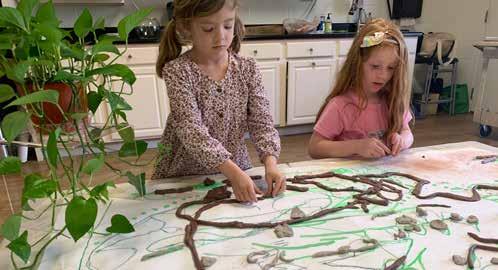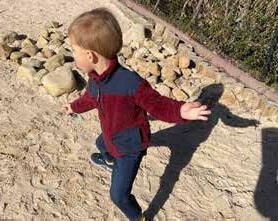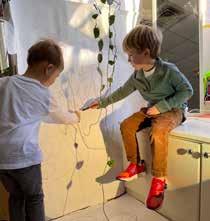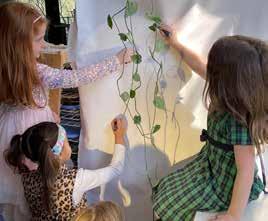
1 minute read
The Creek Room, Pre-K, The Trick of Shadows

One day the children in the Creek Room, Pre-K, were excited to find shadows on the play yard. Intrigued by the shadows made by the trees, slides, and rocks, they began an investigation. In particular, the children talked about their shadows. They were fascinated by the fact that the shadows moved when the light source or object moved. They gave attributes to the shadows that reflected their thinking and theories.
Advertisement

“It is like your shadow is helping you. If you have a shovel and are digging, then your shadow has a shovel and helps you dig.”- Cece “My shadow is strong!”-Cece
When you are holding hands with your friends, then your shadows are holding hands and are friends as well.”- Sebastian “Shadows are reflections.” Cate
On days when the sun was not out, the children wondered where the shadows went and asked, is the sun the only thing that can make a shadow? The children had prior experiences with light sources in the classroom, so the teachers invited them to explore shadows in the studio using different forms of light and objects. They worked with natural materials and crystals to cast shadows. They took time to observe the shadows, sketch what they saw, and make discoveries in the process.
“When you go up with the flashlight, the circle is bigger. When you go closer, the circle is smaller.” Abby Vance
“I noticed when I hold the flashlight so high, the light almost disappears.” Vic
The teachers thought about the children’s encounters, noting that the children understood that a shadow is a dark area where an object blocks light. With this in mind, they invited the children to capture the shadow of a pathos vine. The sunlight streamed in from the window, as well as from a light that was nearby. With this invitation, the children encountered the three-dimensional plant, the two-dimensional shadow, and the reverse projection of the object blocking the light. It was a thought-provoking encounter, indeed!


The vine and its shadow moved as the children explored the plant, positioning the vines to meet their desires. As time passed, the light and the shadow advanced, and the vines seemed to multiply! Then, suddenly, feeling as though the vines were playing a trick, the studio teacher wondered if they should trick the vines in return. She asked the children, “what if we turn the two-dimensional shadow vines back into three-dimensional vines, like real pathos? How could we do that?” The children suggested a material they know well; clay would serve as the trickster material, and work continued, fueled by the delight of playing a trick on shadows.
So, as spring arrives and shadows abound, we invite you to see what tricks the shadows are playing, and perhaps you will be inspired to play a trick in return.






